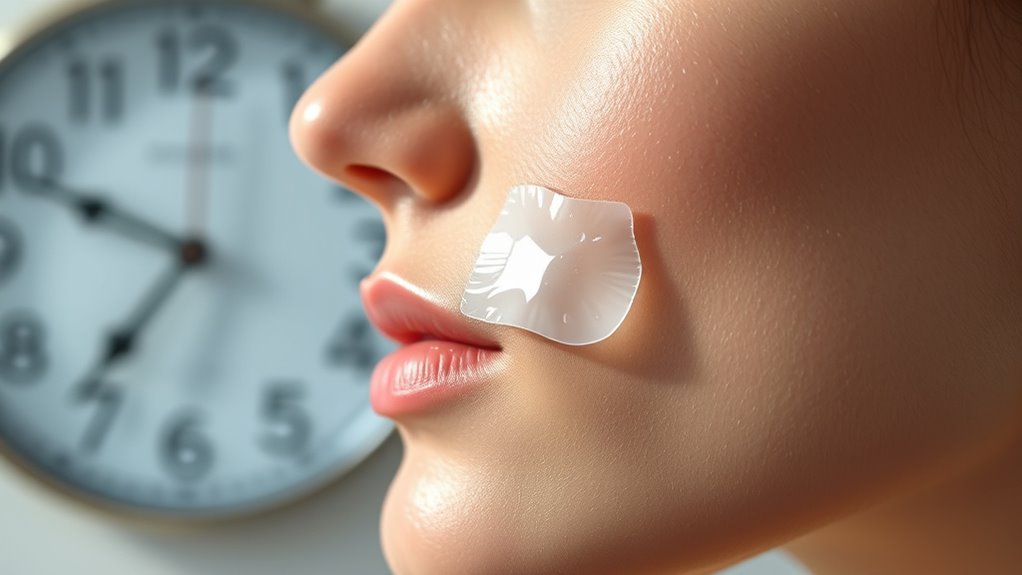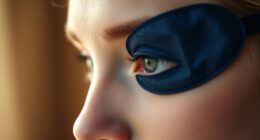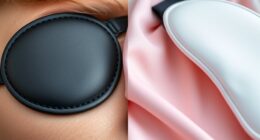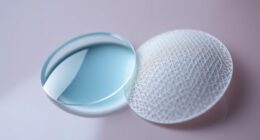To get the best results from a pimple patch, you should leave it on based on the type of acne you’re treating. For whiteheads, aim for 6 to 8 hours; for papules and pustules, 4 to 6 hours is ideal. Cystic acne may require microneedle patches or longer durations. Make sure your skin is clean, and the patch covers the pimple completely. There’s more to discover about optimizing your acne treatment, so keep exploring!
Key Takeaways
- For whiteheads, leave the pimple patch on for 6 to 8 hours; results can be seen in about 4 hours.
- Medicated patches for papules and pustules are effective when worn for 4 to 6 hours.
- Cystic acne usually requires alternative treatments, like microneedle patches, for deeper delivery.
- Ensure the patch fully covers the blemish and press it firmly to maintain adhesion.
- Replace patches every 12 hours for optimal results and healing effectiveness.
Understanding Pimple Patch Functionality
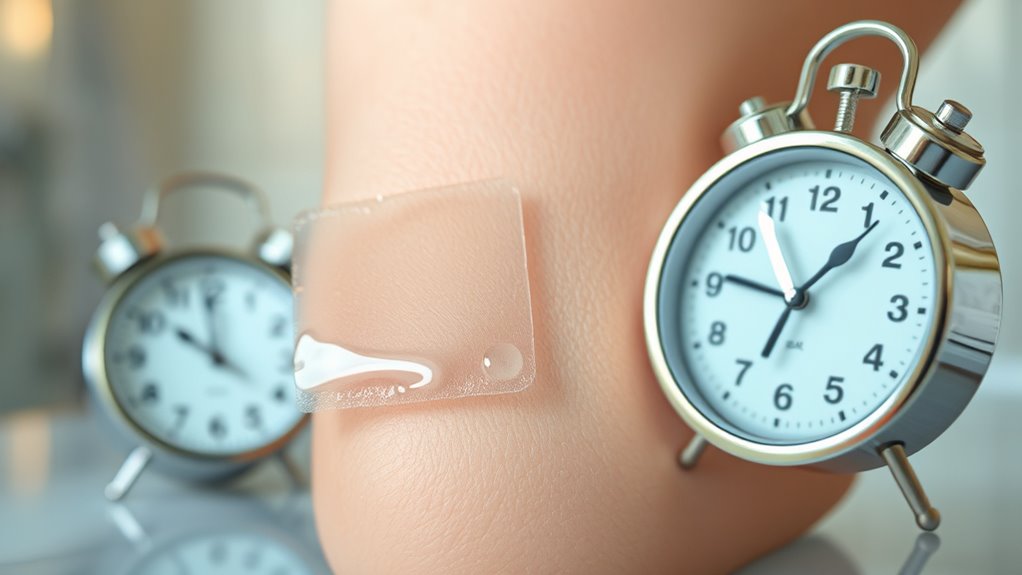
When you apply a pimple patch, you’re utilizing a powerful tool designed to speed up healing and protect your skin.
These hydrocolloid patches absorb excess fluids and impurities, reducing the size of your blemish. Their adhesive barrier creates a protective seal, keeping contaminants out while promoting a moist healing environment. This moisture helps reduce inflammation and redness, enhancing your skin’s appearance. Additionally, these patches are an essential addition to skincare routines for blemish management.
Hydrocolloid patches absorb impurities and fluids, reducing blemish size while creating a protective seal for optimal healing.
Plus, patches prevent you from picking at your blemish, lowering the risk of scarring. Many patches are breathable, ensuring your skin remains comfortable without the worry of maceration.
They’re suitable for all skin types and can be worn day or night, making them a versatile addition to your skincare routine.
Recommended Duration for Different Types of Acne
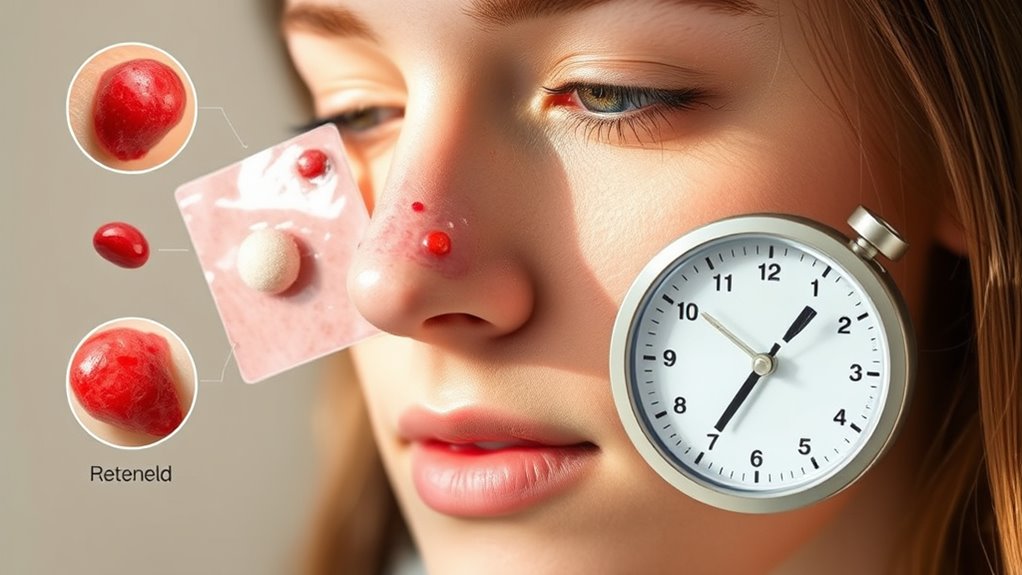
Pimple patches can be a game-changer for targeting specific types of acne, but knowing how long to leave them on is key to maximizing their effectiveness.
For whiteheads, aim for 6 to 8 hours; you’ll often see results as soon as four hours in. Hydrocolloid material in pimple patches helps draw out impurities, enhancing their effectiveness on whiteheads.
Blackheads may need longer durations and active ingredients, while cystic acne often requires alternative treatments like microneedle patches.
Papules and pustules respond well to medicated patches, generally worn for 4 to 6 hours to avoid irritation.
Mild acne can show improvements with shorter wear times, whereas moderate cases benefit from overnight application.
Always consider your skin type and the specific acne type to determine the best duration for your patches.
Factors Affecting Patch Efficacy and Duration
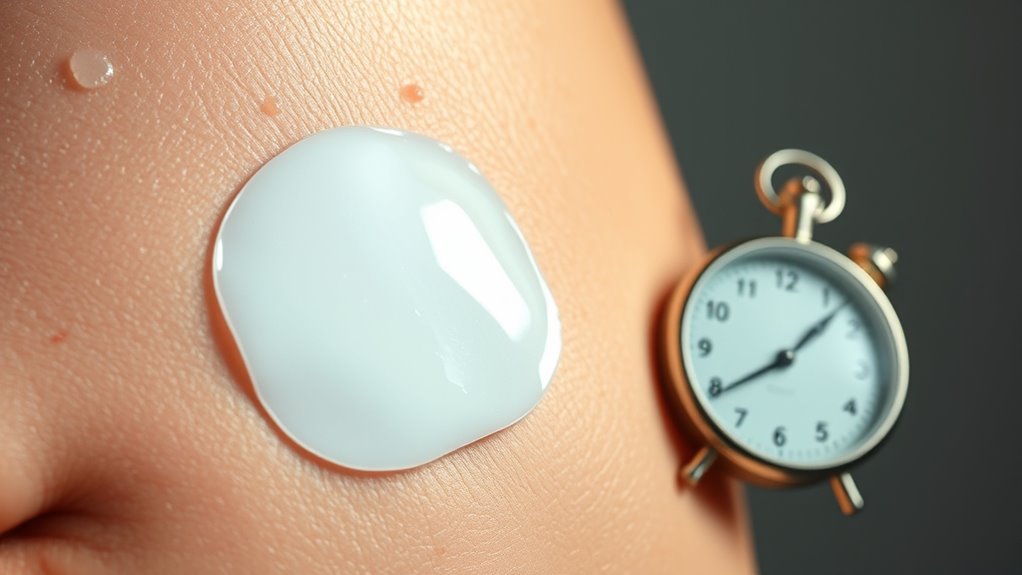
Understanding the factors that affect patch efficacy and duration can greatly enhance your acne treatment experience. Your skin type plays an essential role; for instance, oily skin can reduce patch stickiness. The type of acne matters too—patches work best on whiteheads and are less effective on blackheads or cystic acne. Quality varies among brands, impacting absorption and ingredient delivery. Individual reactions to patch materials can cause irritation, so be mindful of your skin’s sensitivity. Additionally, using patches designed for cystic acne treatment can provide more targeted relief for deeper blemishes. Finally, these patches serve as a barrier against environmental pollutants, aiding in healing. Pimple patches are a targeted solution for breakouts, allowing for maximum absorption of impurities and promoting faster healing. Taking all these factors into account will help you optimize your pimple patch use and achieve better results in your acne treatment journey.
Tips for Optimal Pimple Patch Use

To get the most out of your pimple patches, proper preparation and application are key. Start by cleansing your skin with a gentle cleanser to remove dirt and oil, then pat it dry to promote better adhesion. Choose a patch that covers the entire pimple for best results. Press the patch firmly onto your skin and apply it smoothly to avoid air bubbles. Remember to wash your hands before applying or removing the patch. For best results, wear the patch overnight and replace it every 12 hours. Avoid touching or picking at the pimple while wearing the patch, as this helps prevent bacteria from getting trapped. Pimple patches are designed to provide effective results with patience and care, so consistency is essential for clear skin, making patch use a regular part of your routine.
Comparing Different Types of Pimple Patches
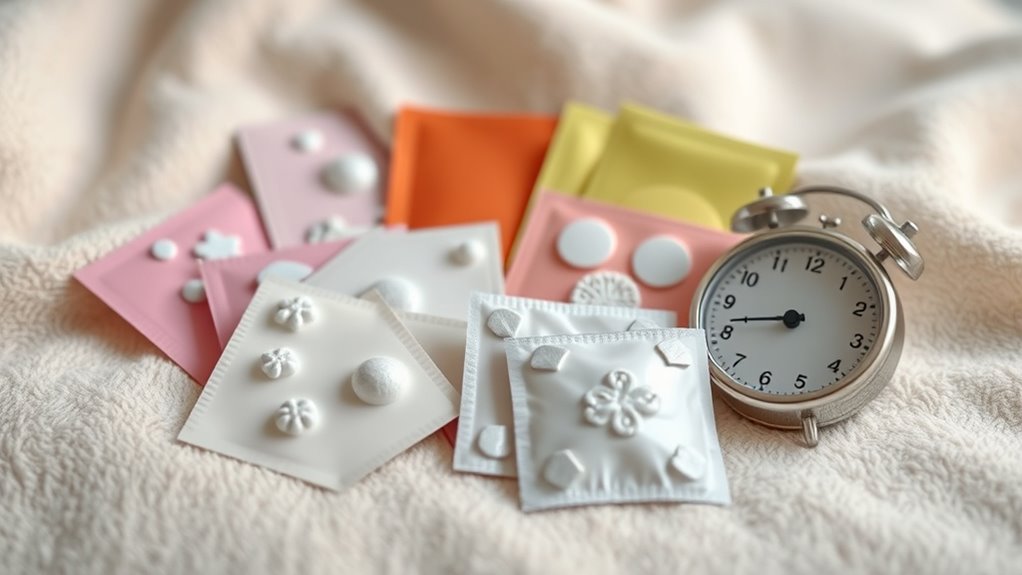
When it comes to treating acne, knowing the different types of pimple patches can make a significant difference in your skincare routine.
Hydrocolloid patches are great for whiteheads and pustules, as they absorb pus and oil. They are typically made of hydrocolloid material, which draws out fluids from the pimple. These patches often enhance effectiveness by providing a protective barrier against external irritants.
Medicated patches contain ingredients like salicylic acid, targeting inflamed acne effectively.
If you’re dealing with cystic acne, microneedle patches deliver active ingredients deeper into the skin.
Non-hydrocolloid patches focus on applying acne-fighting ingredients directly to blemishes.
Hybrid patches combine the benefits of hydrocolloid and medicated patches.
Depending on your skin type, oily skin may need patches with strong adhesion, while sensitive skin benefits from gentler options. Choose wisely for the best results tailored to your acne type!
Long-Term Care and Maintenance for Clear Skin
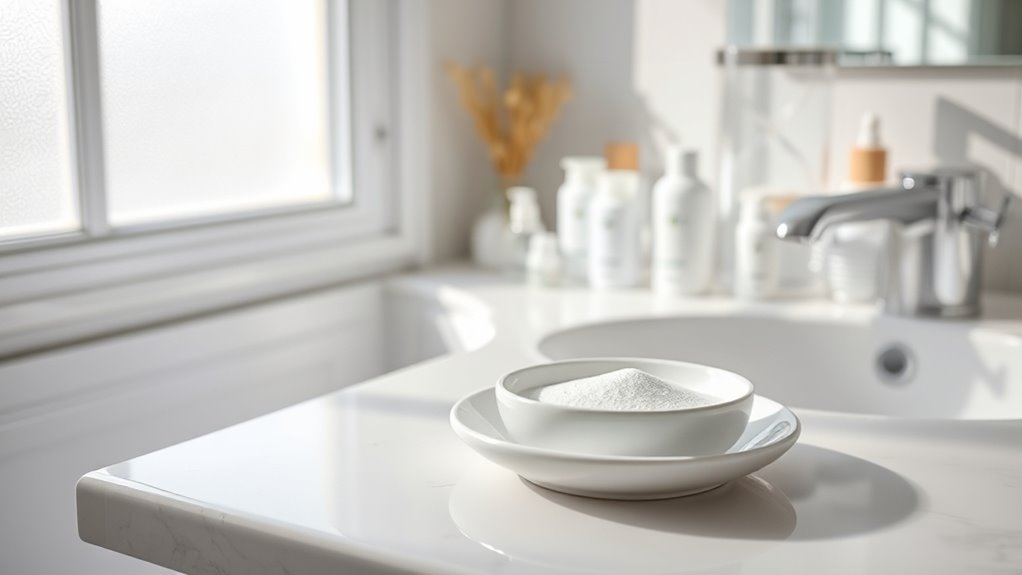
Achieving and maintaining clear skin requires a consistent long-term care routine that addresses various skin needs.
Start by cleansing your face twice daily to remove dirt and impurities. Follow this with a quality moisturizer to lock in hydration and prevent irritation.
Don’t forget sunscreen—applying broad-spectrum SPF 30 daily protects your skin from harmful UV rays. Stay hydrated by drinking plenty of water, and incorporate gentle exfoliation to promote smoothness. Consistent skincare routines not only enhance the health of your skin but also support its barrier repair and resilience.
Consistency is key; it helps maintain skin resilience and reduces the appearance of acne scars. Consider professional treatments like facials every 4-8 weeks for a refreshed look.
Finally, choose high-quality products, including serums and retinol, to target specific concerns and enhance your skin’s overall health.
Frequently Asked Questions
Can I Use Pimple Patches on Broken Skin?
You shouldn’t use pimple patches on broken skin.
They can trap bacteria and slow healing, worsening the situation. Instead, wait until the area is clean and dry before applying a patch.
Once it’s healed, you can use patches to protect the skin and help with recovery.
Always consult a dermatologist if you’re unsure or dealing with severe cases, as they can provide personalized advice tailored to your skin’s needs.
How Often Can I Use Pimple Patches in a Week?
Pimple patches can be your skin’s best friend, but don’t overdo it! You can use them daily if your skin tolerates it, but listen to your skin’s needs.
If breakouts strike, reach for those patches, but avoid applying them too often on sensitive areas to prevent irritation.
Ideally, rotate their use throughout the week and keep an eye on how your skin reacts.
Balance is key, so find what works best for you!
Are Pimple Patches Safe for Sensitive Skin?
Yes, pimple patches can be safe for sensitive skin, especially those like Neutrogena’s that dermatologists recommend.
They’re made of hydrocolloid material, creating a moist environment that helps reduce irritation.
While most users find them gentle, you should still check for any personal sensitivities to ingredients.
To minimize risks, apply them to clean skin, avoid other products beforehand, and monitor your skin reaction for any signs of irritation.
Can I Apply Makeup Over a Pimple Patch?
You might wonder if it’s okay to apply makeup over a pimple patch. The truth is, you can!
Hydrocolloid patches create a smooth surface, making it easier to apply foundation. Plus, they protect the pimple from bacteria, reducing inflammation while you wear makeup.
Just use a light touch and opt for a matte concealer for the best results. This way, you can cover up without compromising healing or risking more breakouts.
What Should I Do if a Patch Irritates My Skin?
If a pimple patch irritates your skin, act quickly to soothe the area.
Remove the patch gently and apply a cold compress to reduce redness and inflammation. Use a gentle moisturizer to hydrate and calm your skin.
Avoid reapplying the same patch until irritation subsides, and consider trying a different patch with milder ingredients.
If irritation continues, consult a dermatologist for personalized advice and treatment options tailored to your skin’s needs.
Conclusion
So, there you have it! Stick that pimple patch on for six to eight hours, and you’ll be well on your way to a clearer complexion. But hey, if you’re looking for a miracle in a single night, you might as well be waiting for unicorns to show up at your door. Remember, patience is key—just like waiting for your favorite pizza delivery that always seems to take forever. Enjoy the journey to flawless skin!
